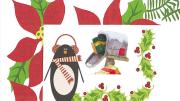On Christmas Day 1948, 28-year-old Marie Harris took to the typewriter in her family’s Shedd, Oregon, farmhouse and wrote the first holiday family newsletter in recorded history. People had been sending one another handwritten holiday cards since the Victorian era, but after Marie and her husband moved three times and had three children in the span of several years, she felt there was “much too much news” for a 3-by-5 notecard. Her first Harris Herald was a three-page update full of the quotidian in all its sweetness: their house had green shutters, her husband Bob got the flu, and they were all “very much impressed” with their yard’s rhododendron and azalea plants. She signed off with an enticing offer: “Bob has learned to milk and will be happy to demonstrate for you, if only you come see us.”
Marie’s might have been the first, but by the 1980s, it was a bona fide American yuletide tradition to accost acquaintances with multi-page, clip-art-decorated missives of covert bragging and oversharing about the year. (One woman accomplished both in one go when she relayed that her daughter was a purple belt in karate and couldn’t keep food down after her appendectomy.) In the 1990s, an archivist at the Smithsonian Museum of American History, Susan B. Strange, began gathering these scraps of history, and now her collection of more than 1,500 letters, from about 100 families, written between 1948 and 2011, resides in the Radcliffe Institute’s Schlesinger Library.
Many of the letter writers have a real estate agent’s eye for embellishment. A woman whose son learned to ride a bike reported that he’d mastered “the two-wheeler before the age of four.” One couple wrote an acrostic for “Merry Christmas,” where the “E” stands for “Every morning finds us at the gym.” During the Great Recession, a man said that he was humbled to have received a high-definition TV as a gift from his employer. And in 2011, a woman wrote that she’d found her bliss “eating a warm dish of organic food after an exhilarating class with my yoga teacher, Marco.”
For all their quirks, family holiday newsletters contain a powerful dose of life. Marie wrote her letters for 54 years, during which time her first husband died, America went to war in Vietnam, Marie remarried and traveled the world, her children grew up, the personal computer was invented, Marie became a college professor, her children had children, 9/11 happened, and then Marie’s grandchildren had children. “How come this happened so fast?” she asked in her forty-third letter. After she died in 2003, her husband continued the tradition, and her children and grandchildren started family missives of their own. Maybe these love-to-hate-them newsletters endure because, as Marie put it in 1968, “Life is too full of wonderful things to do, places to go, and people to know” for one little notecard.









